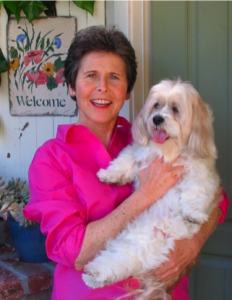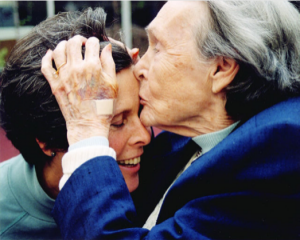
Beth Corwin is a Certified Activity Director with a passion in exploring, developing, and experimenting with what she calls the “Restorative Arts.” For over a decade, Beth has worked one-on-one with aging clients to restore body, mind, and spirit, sometimes even arresting or reversing the effects of the aging process.
At over 60 years old, Beth is “happy proof” that her practices are sound and innovative.
Twelve years ago, Beth decided to change her life, and she went from a comfortable career in design to working as an Activity Director helping seniors. For five years, she worked for Sunrise Senior Assisted Living of San Mateo, where she was able to focus on developing and discovering practices to help strengthen the minds and bodies of her aging clients. As a result, she developed a holistic program called “The Restorative Arts.”
Beth’s independent work began with her Birthdays for Seniors Program, in which she supplies a self-contained celebration for home-bound clients. She now trains staff at assisted living facilities and home care staff, she is placed in homes to work directly with seniors, and she offers free monthly seminars on preventing memory loss. The next seminar, “How Your Daily Habits Lead to Early Memory Loss” takes place September 15. You can contact Beth for more information and future dates.
Dana: What services do you offer, and how did you come about developing them?
Beth: I coordinate activities for memory preservation. Basically, there are six things that one can do to build new brain cells. When people have brain injuries, other parts of the brain can take over task – so why can’t we do that with people who have dementia?
What’s important about these is that they have to be novel and complex – all the things you always put off. So my job is to do new things and make them fun. The activities center around:
-
Learning a new dance.
-
Seated exercise.
-
Learning a new musical instrument
-
Brain-challenging activity.
-
Practicing spatial arrangement.
-
Learning a new language – I start with basic Sign Language.
I use a lot of artwork for spatial arrangements and hand-eye coordination. It helps to buld and create things. There are aslo a lot of games that I play. I find out what the client’s weakness is – eyesight, hearing, arthritis … and I make a game that accommodates. One example was I used wood blocks and made dominoes for a client who loves to play dominoes and couldn’t pick them up anymore.
The key is that it’s just a challenge, but not so difficult that they won’t do it
Dana: Could you do activities like this throughout life to prevent memory loss?
Beth: Well, there’s no guarantee. Nothing can prevent Alzheimer’s. Many brilliant people will be affected, or you could have a stroke, etc.
The trick is to always find things that challenge you. That’s what builds new connections in the brain.
It helps to have someone in the family who can help, too. You just have to have one person who’s excited about it, as long as they’re trained. It makes the activities fun to do.
Dana: How do you incorporate these types of activities into your work at memory care facilities?
I’m aways honest, and I make it fun and enjoyable. I know not to coddle my seniors. I tell them the truth.
Dana: Do you see them coddled a lot?
Beth: Yes, people like do things for them. People think they’re too old or can’t learn or don’t want to. It’s important for them to work with someone who is trained. When people are at home, no matter how much you’ve loved your loved one, you don’t have the expertise or staffing to give them the help they need.
The best time to bring them to me is when they are first experiencing memory loss early on, rather than wait.
Dana: Do you primarily work with those who have dementia?
Beth: I work with different people at different stages of their learning. I also offer a two-part seminar on ways to protect against memory loss.
Dana: Those are for younger people?
Beth: Yes, with people in their 40s, losing memory to stress.
Dana: How does stress lead to memory loss?
Beth: You get that fight or flight response, and your body doesn’t know that the stress is going to end, and this affects your brain. When you’re in a constant state of stress, this creates inflammation in your body, and your body releases Cortisol, which is so toxic it actually kills brain cells.
When parts of your brain become damaged, eventually that part of the brain will die, the neurons that create the memories can no longer make the connections.
To avoid this, throughout life, avoid things that cause inflammation and cortisol production: Lack of exercise, overweight, some foods are believed to cause Alzheimer’s. And there are some foods that can prevent it.

Dana: Do the kinds of activities you promote actually reverse these physical effects to the brain?
Beth: No, you can’t reverse Alzheimer’s . With these activities, instead, you’re making new connections.
It’s like they say: If you don’t use it, you lose it. That’s true for the brain, too. Like these elderly folks watching TV all day and not getting stimulation. It breaks my heart. Families of my clients will come to me and say, “Mom hasn’t done this in 20 years! I haven’t seen her this happy.” It’s about doing those activities that you always put off.
Dana: How does your own age and life experience impact how you work with seniors?
Beth: I was raised by grandparents who were not kind people, and adopted at fourteen by a Jewish family, whose grandmother lived with them and wouldn’t even talk to me because I was a Gentile. At the time, I thought that’s what all elderly people were like.
Over the course of three years twelve years ago, I met three women who completely changed my view. In particular, one elderly African American blind woman who took me to a luncheon, and I was surrounded by elderly African American women who were all vital and kind, and I thought, “This is what you’re supposed to do with your life.”
I was making a good living as an interior designer at that time, and wanted to change my life. Working with these folks healed my childhood traumas, and I never expected that.
I have seen what has impacted them – the two major things that impact someone in old age – falls and memory loss. I have a background in yoga, meditation, and karate, and I used that to focus on clients getting more exerciee and blance, and strengthening.
Everything I’ve ever learned I have been able to bring together to apply to helping improve my seniors’ lives. I started to hold seminars on aging, Alzheimer’s, and memory loss, and I learned how to create activities that can help.
For example, with BINGO, we changed it to visual bingo to work a different part of the brain than they were used to using. Also, bringing in children, either their grandkids or others. Anytime you can engage a child working with a senior is very important.
Dana: Why is that? Is it a cognitive or emotional effect?
Beth: As far as strangers, seniors are more likely to engage with children than with adults. Women especially love to engage with teenage boys. Grandfathers seem to engage with young women. I don’t know if they are making a connection with their young children, or their young spouses.
As far as Alzheimer’s prevention, people need to be engaged in life. They have to be loved, feel important. Having a child in their life provides this, makes them happier. Many elders are at home, untreated for depression, which leads to inactivity and memory loss. I see children adding a whole new dimension to this.
Dana: How do you see dementia impact a person who knows they have it?
Beth: Alzheimer’s has seven stages, and in the first two stages, you’re aware there’s a problem. People are frustrated and scared. You know you’re losing your memory. It’s terrifying.
Dana: Do you work with people in those stages as well?
Beth: Yes, I work with people at all kinds of stages of learning. In later stages, people are unaware there’s a problem. It becomes hard on the families, but is no longer hard on the person.
People need to be engaged in these stages, and family members and caregviers tend to forget that. Even though they can’t talk, it doesn’t mean they aren’t there. Anything that will engage a person is great. We use dogs – some people who never talk will sit right up and talk with a dog.
Dana: So you just need to find what it takes to engage some people?
Beth: Yes, not just people with Alzheimer’s – some people just feel life has passed them by, they’re depressed, and they’re grumpy, maybe they’re in pain.
I always keep this in mind: Years ago my mother was in a coma in New York. On my very first trip back to San Francisco after visiting her, I sat next to a woman, and we got to talking, and I found out she had been in a coma. She said that she had thought she’d been talking to family along. I apply that to my folks with Alzheimer’s – I act as if they believe they’re talking to me and interacting with me, even when I can’t see it.
Dana: How?
Beth: You speak softly and quietly, you approach with kindness, and love and respect, treat them like they’re the most important person in the world. Touching, reading to them, playing music. Bring in their dog or cat. Find every single way you can soothe them, in later stages. Find out what they did as children, for example. Even if someone can’t talk you’ll know that they enjoy what you’re doing with them.
Dana: Do you think that that’s why engagement goes away?
Beth: Yes, people assume they’re not there. They assume the brain has died, and that’s not true. If their heart is still beating, their soul is still there.
Dana: Is there anything else you’d like to share with our readers that I haven’t mentioned?
Beth: Just to do whatever you can to make your loved one happy.
Dana: Thanks for taking the time to talk with us!
You can learn more about Beth at her website, or contact her by phone with any questions: 415-264-3655.

 What is Restorative Art? – An Interview with Beth Corwin
What is Restorative Art? – An Interview with Beth Corwin


 First the Wealth Gap, Now the U.S. Has a Growing Health Gap
First the Wealth Gap, Now the U.S. Has a Growing Health Gap

 Our Annual Seven Holiday Gifts for Someone Who Is Grieving, 2024 Edition
Our Annual Seven Holiday Gifts for Someone Who Is Grieving, 2024 Edition














